You are using an out of date browser. It may not display this or other websites correctly.
You should upgrade or use an alternative browser.
You should upgrade or use an alternative browser.
Getting started with aperture sights for rimfire:
- Thread starter Biologist
- Start date
Biologist,
I have seen a few fullbore shooters, mostly from the West Indies that use the sight mounted lens holder. These can be set up to sit almost touching the iris. This might be the best option if you are required to wear full safety glasses. Beside using Knobloch shooting frames for rifle shooting I also have a pair of Wiley-X with Rx inserts that I use as sunglasses/shooting glasses for shotgun sports.
I have seen a few fullbore shooters, mostly from the West Indies that use the sight mounted lens holder. These can be set up to sit almost touching the iris. This might be the best option if you are required to wear full safety glasses. Beside using Knobloch shooting frames for rifle shooting I also have a pair of Wiley-X with Rx inserts that I use as sunglasses/shooting glasses for shotgun sports.
I found that with my Schuetzen rifle, a 32-40 with a 209gr bullet at 1400fps, @ 100 or 200yds, that I ended up shooting 1 point difference in switching from scope to irons, I was using a Walther rear and an Anschuts frt sight. We always shot 1 rd ea of 10 shots, iron bench, iron offhand, scope bench, scope offhand in a day. I gained a lot of respect for what could be done with a peep sight from that.
machohugeaxe
Regular
- Location
- Peel Region, Ontario
Yea I think it was just a combination of small eyes for me and slight remaining astigmatism after LASIK many years ago. Put a blinder on and the issue is mostly gone, I just have to open my eyes really wide haha...
It's definitely astigmatism, has nothing to do with eye position to rear sight.
I have used 3 different rear aperture, one fixed size at 1.1mm, one with iris from 0.5-3.2mm, one with iris from 0.8-2.8mm, all the same regardless where I position my eye.
I have myopia -2.75, presbyopia +1.75, astigmatism -1.5.
When I wear my Rx glasses, this issue is less profounding. When I wear contact lens without astigmatism correction this issue is very much profounding. I asked my eye doctor, he confirms that.
As other said, a blinder helps a bit, but not completely solve the issue. So does the enlarged rear aperture. I turned my rear to 1.5 to 1.8mm and I feel comfortable. But I have rear diopter which enlarges the front sight/aperture from 1x-1.5x, so 1.8mm rear aperture is not too big for me.
Bought the 250 pack of SFC targets for ISSF 50m Match Rifle, and 250 pack of 50m Sporting Rifle. On Cibles website I bought the 50m ISSF center patches. I am now flush with a great target supply.
I cut the rear aperture sight extension rail only 2 cm off, so its about 18cm long now. (hack saw and fine file to clean up the edges, easy to do). Underneath the rail is actually a nice slot to securely wedge my grip/trigger hand. I am glad I did not trim it back further. This is very comfortable at the bench. I have not tested this for offhand shooting yet. I suspect that the extension rail will be fine and the only adjustment for offhand will be sliding the aperture sight a tad forward.
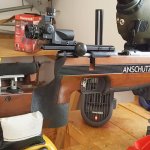
To make sure no sharp edges cut my hand, I coated the cut end with Liquid Electrical Tape. You can see this goop on the cut end in the above photo.
With my Rx glasses, its difficult to get close enough to the rear iris aperture without contacting it with my glasses. To prevent scratching my lenses I coated the rim of the rear aperture eyepiece with Liquid Electrical Tape. I now contact the aperture eyepiece with my glasses no problem. I applied it to the edge with a toothpick and the results are great.
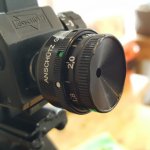
This liquid electrical tape stuff is great, and I am finding other uses for it. I never knew this stuff existed until recently.
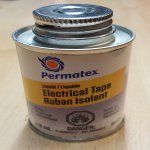
The front aperture adjustment diameter I am liking ranges from 3.6 to 4.0mm. For the rear iris, I really see the advantage to having this for making the white halo and aperture edges crisp, and I adjust it from 1.2 to 1.7 depending on the light conditions. It was a good investment, although I am not using the colour filters and staying with the clear. So I am not sure the colour filter rear iris was worth it, but we'll see.
My local rimfire 50m range outdoor target stands (shot from our heated shooting house) are too small to attach the 26 inch tall SFC ISSF Match targets. So I have to cut off the 2 sighter targets and use the remaining 4 for record targets. I cut the edges off the Cibles center patches and taped it in the center for a sighter.
Recent 50m practice results on the bench shot from inside our heated shooting house: 195-10X on the ISSF 50m Match target with the Cibles center patch target taped in the middle for the sighter (four 5-shot groups for max score possible out of 200-20X).
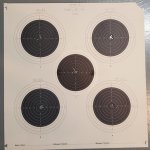
When the warmer spring weather gets here, I will be out on our 50m unsheltered range attempting my first offhand shooting. I expect group size to balloon to outrageous proportions!
I cut the rear aperture sight extension rail only 2 cm off, so its about 18cm long now. (hack saw and fine file to clean up the edges, easy to do). Underneath the rail is actually a nice slot to securely wedge my grip/trigger hand. I am glad I did not trim it back further. This is very comfortable at the bench. I have not tested this for offhand shooting yet. I suspect that the extension rail will be fine and the only adjustment for offhand will be sliding the aperture sight a tad forward.

To make sure no sharp edges cut my hand, I coated the cut end with Liquid Electrical Tape. You can see this goop on the cut end in the above photo.
With my Rx glasses, its difficult to get close enough to the rear iris aperture without contacting it with my glasses. To prevent scratching my lenses I coated the rim of the rear aperture eyepiece with Liquid Electrical Tape. I now contact the aperture eyepiece with my glasses no problem. I applied it to the edge with a toothpick and the results are great.

This liquid electrical tape stuff is great, and I am finding other uses for it. I never knew this stuff existed until recently.

The front aperture adjustment diameter I am liking ranges from 3.6 to 4.0mm. For the rear iris, I really see the advantage to having this for making the white halo and aperture edges crisp, and I adjust it from 1.2 to 1.7 depending on the light conditions. It was a good investment, although I am not using the colour filters and staying with the clear. So I am not sure the colour filter rear iris was worth it, but we'll see.
My local rimfire 50m range outdoor target stands (shot from our heated shooting house) are too small to attach the 26 inch tall SFC ISSF Match targets. So I have to cut off the 2 sighter targets and use the remaining 4 for record targets. I cut the edges off the Cibles center patches and taped it in the center for a sighter.
Recent 50m practice results on the bench shot from inside our heated shooting house: 195-10X on the ISSF 50m Match target with the Cibles center patch target taped in the middle for the sighter (four 5-shot groups for max score possible out of 200-20X).

When the warmer spring weather gets here, I will be out on our 50m unsheltered range attempting my first offhand shooting. I expect group size to balloon to outrageous proportions!
Attachments
https://www.canadiangunnutz.com/forum/forumdisplay.php/215-Postal-Match-Results-and-Rules
If you go to the top of the Rimfire section there is . . . Postal Match Results and Rules
As you scroll through there are various targets but may require some playing around with it.
The 8" bullseye was used for our 100 Metre but it faded away.
If you go to the top of the Rimfire section there is . . . Postal Match Results and Rules
As you scroll through there are various targets but may require some playing around with it.
The 8" bullseye was used for our 100 Metre but it faded away.
https://www.canadiangunnutz.com/forum/forumdisplay.php/215-Postal-Match-Results-and-Rules
If you go to the top of the Rimfire section there is . . . Postal Match Results and Rules
As you scroll through there are various targets but may require some playing around with it.
The 8" bullseye was used for our 100 Metre but it faded away.
Thanks Horseman2 for that heads up on the "Postal Match Results and Rules" Sub-Forum. I had seen that in the directory but never opened it to see what's in there.
Alot of old threads in there for many events and individual practice sessions. I clicked around and found the thread "New targets and possibly new matches" that still has some live links to target image files: https://www.canadiangunnutz.com/forum/showthread.php/497274-New-targets-and-possibly-new-matches
I forgot to mention in my post that I also bought from Cibles a 250 pack of the 100m smallbore targets. These are 8 inch aiming bulls. However I was somewhat disappointed with this pack because the paper is thin, not anywhere close to card stock quality. But no worries, I will use them.
The 50m targets from SFC (ISSF 50m match and SFC 50m Sporter) are very good paper quality, not card stock, but I understand that because they are huge (26 x 16.5) and that slightly thinner paper thickness is a good tradeoff for saving some costs (in both printing and shipping the heavy packs), and I am happy with them.
The 50m ISSF center patches from Cibles are excellent and cardstock quality.
I personally do not need to buy targets, as I have the computer capability at home to make any design for me and my club, as long as I have the specs, and if the printing shop has the paper. I find the shooting organization's rule book online that specifies the target ring dimensions, then make them on screen, then convert them to PDF and get them printed locally on card stock.
I did want to support SFC and Cibles so I purchased their products, and the costs worked out to reasonably similar to getting them printed here on card stock. I will likely buy from them again.
It looks like the Postal Match Sub-Forum has not been used much in recent years. Any ideas on how to revive it?
Biologist, you have me thinking about aperture sights.
I see you have the 6384 aperture sights. Knowing what you now know, if you were buying the sights today and of course if the price difference were not an issue, would you stick with the 6384 set or get the 7020 set? Which iris aperture would you recommend? Other than the sight line extension for benchrest, would you make any other recommendations?
I see you have the 6384 aperture sights. Knowing what you now know, if you were buying the sights today and of course if the price difference were not an issue, would you stick with the 6384 set or get the 7020 set? Which iris aperture would you recommend? Other than the sight line extension for benchrest, would you make any other recommendations?
Great thread and set-up, Biologist! I'm especially envious that you can simply raise the window and shoot......
Biologist, you have me thinking about aperture sights.
I see you have the 6384 aperture sights. Knowing what you now know, if you were buying the sights today and of course if the price difference were not an issue, would you stick with the 6384 set or get the 7020 set? Which iris aperture would you recommend? Other than the sight line extension for benchrest, would you make any other recommendations?
Hi Grauhanen. I started writing and ended up with an overly long-winded response, so please excuse the verbosity of it all.
It is so long the software made me divide it into two parts.
PART 1:
Re: Question of rear aperture sight choice 6384 set vs 7020 set, if price was no object:
I bought my sights at Nordic Marksman (they have excellent service, one of my favourite stores), and they offer sights as a front and rear set, and separately. Knowing what I know now, I could select parts separately al la carte. But if in doubt, the sets are a good option, and I think they offer a discount for the set.
Also at the time I was focused on Anschutz brand, but of course there are several other excellent brands. I think the industry has standardized threads for accessories such as irises to fit each other's brands, but I am not totally certain about that.
Before I start, I must say that Anschutz number product codes for everything drive me crazy. I wish they had a more functional model name, or a comparison of features table in their catalogue or something. A major hurdle to buying anything Anschutz is just learning to keep all the number coded models and sets separated in your mind for the features. I had to write out detailed product codes and descriptions in my notes when I was making purchase decisions to keep track of what the heck they all mean! Examples below in my response.
REAR SIGHTS:
The 6384 set comes with the 6805 rear sight (already we see two different bloody codes for the same rear sight in a set vs separate purchase!). The 6805 has 10 clicks per revolution on the turrets, and at 50m that is 2.0mm on target. The 7020/20 set comes with the 7002/20 rear sight (that is not a typo: 2 more different product codes for the same sight!), with 20 clicks per revolution, which is 1mm per click at 50m, and this sight rotates for cant. For positional shooting I see videos and product photos of shooters setting up their buttstocks and sights with alot of cant to fit their unique preference. If one day I get into competitive positional shooting, I may have to go that route but for now I will have to manage without the rear sight cant feature. The 7020/10 set (with 7002/10 sight) comes with the 10 clicks per revolution and 2.0mm clicks at 50m.
With some experience, I now notice the coarseness of the 2mm clicks at 50m. Originally I thought that I would never notice the difference between 2mm vs 1mm clicks because (a) I am not that good, and (b) that dimension is well within the group size variability of the ammo, and (c) if there is wind its going to open up the groups anyway. However I was wrong in this logic for the precision of bench rest shooting.
Bench rest shooting with good ammo and a good rifle and solid support in the bags can be very precise on target. (e.g I was successful in the five 1/2 inch groups 50m challenge with apertures using SK Biathlon Sport ammo). Even though 2mm is just a wee bit tinier than 1mm, the error it induces is 1mm additive to the ammo's dispersion. There have been perfect no-wind conditions where I center the black bull in the white halo, then ever so slightly have to cheat (hold) one way to compensate about 1mm for the "gap" of the 2mm clicks that I am seeing printing on paper through my spotting scope. The ISSF 50m X-ring is very small, and the 10 ring is also not generous, and every mm matters for the 10-X scores. So in hindsight I do see the advantage to 20 clicks per revolution with 1mm increments at 50m for bench rest shooting.
Short answer to the original question: If money was no object, Yes, I would buy the 7002/20 rear sight in the 7020/20 set. The 1mm clicks at 50m is better for precision than 2mm clicks.
So I am learning to compensate with the ever so slight cheat (hold). I think you need to hold anyway for windage variation when watching the flags to make an instant correction at the trigger pull when the switching is too quick to make a mechanical click or two. Same as shooting with a scope - hold for the correction at the moment of trigger pull while watching the flags with your other eye. So in the long run the 1mm click advantage at 50m with the more expensive unit might be able to be compensated for with sighting skill and wind reading skill. Without wind reading skill you are done for anyway.
The elevation slight hold, if needed to fill that 1mm gap between 2mm clicks is sometimes needed, if the wind is not overpowering it. And sometimes I cannot tell if my clicks or anything worked to improve score because of the ammo dispersion that is a rimfire fact of life anyway, especially with mid grade ammo.
I have yet to try classic 3-positional shooting unsupported where my rifle will be shaking and group size will open way way up. I doubt that the extra money for the 1mm clicks at 50m will be of any benefit since my induced error will be much larger and more variable.
Rear Sight Iris addition:
The standard rear sight aperture that comes with these Anschutz units from the factory is a 1.1mm aperture. If that is all you have you will be fully functional, good to go. I wear eyeglasses and have a problem with getting close enough to the aperture to get the full sight image, and that is why I mentioned in previous posts that I need to press my eyeglass lens onto the aperture.
I bought the Anschutz 5-colour iris rear sight aperture 9560. I am glad I bought this for the adjustable aperture. The variable light conditions make a difference in the sight picture for my eyes. In my limited experience so far, I find it does amazingly control the crispness of the black and white rings in the sight picture.
So far, my typical adjustment range for the rear iris is between 1.2 and 1.7, with 1.4 being what I use most of the time at 50m (I have not yet tested this at 100m). I think the larger opening also offsets the disadvantage I have with my eyeglass lens increasing the aperture-to-eye distance.
So far I am not using the colour filters and simply use the clear view. I did try the yellow filter which improves contrast on dull days. The other colours significantly darkened the view and I did not like these. (Maybe for indoor fluorescent lights these various colours are useful?). So if I was going to purchase a rear iris today, I might save money and get the one without the colour filters since I am only shooting outdoors and need all the light I can get, and if it is super-bright, the iris can be turned down to darken the image.
Part 2, next post are my thoughts on the front sight.......
Last edited:
PART 2:
Front Sight:
The 6384 and 7020/20 and 7020/10 sets come with the same front sight (M18 or M22). I went with the M18 size. On hindsight I maybe should have gone with the M22 which can provide more target image for sorting out multiple bulls on one target sheet, but I have no experience with the M22 so can't really say.
The globe in this set rotates for cant, but so far I use it without cant. I purchsed a plastic aperture insert set initially, and experimented with various aperuture sizes.
I purchased the Anschutz M18 Front Spirit Level, and glad I did. I cannot imagine shooting without this. When I cant the rifle to move the bubble, I can see a huge shift in sight image for the rings, so I know the bubble level makes a huge difference for precision and accuracy.
I purchased the Centra Front Sight Standard Iris (M18), and am really liking it. This adjusts from 2.3 to 4.3 mm. For a begiiner like me, it allows for alot of low hassle easy experimentation for the sight picture of black and white rings, without the extra work of having to remove and replace inserts. However it is a luxury - one can get the same results with inserts.
So far on the front iris I am using a range of 3.6 to 4.0 mm front aperture openings at 50m, with ISSF 50m match targets. I have not tested this at 100m yet. With different sized targets or aiming bulls, I think this front aperture preference might change. I could have managed OK with the plastic inserts and saved some money. But the iris has the pure black ring, whereas the plastic inserts I have are the cheap ones with ground plastic and more like a gray ring, not as crisp and contrasty as the black ring of the iris or metallic inserts.
They do make plastic inserts (in clear and colours) with a high precision black metal ring, but NM did not have a set in the M18 at the time. No doubt these are just as good as an iris. They also make high end glass inserts with black metal rings, but a full set of these are expensive and hard to find in stock. I am very happy with the adjustable iris front aperture. I don't need to carry a box of inserts in my kit.
I did not want the Vario option which has the vertical crosshair option. I practiced with the plastic inserts before the iris purchase, and I determined that I like the cleanest open sight picture possible and that the horizontal crosshair is all I need, along with the bubble level.
If anyone is still awake reading this, I hope it was helpful.
Front Sight:
The 6384 and 7020/20 and 7020/10 sets come with the same front sight (M18 or M22). I went with the M18 size. On hindsight I maybe should have gone with the M22 which can provide more target image for sorting out multiple bulls on one target sheet, but I have no experience with the M22 so can't really say.
The globe in this set rotates for cant, but so far I use it without cant. I purchsed a plastic aperture insert set initially, and experimented with various aperuture sizes.
I purchased the Anschutz M18 Front Spirit Level, and glad I did. I cannot imagine shooting without this. When I cant the rifle to move the bubble, I can see a huge shift in sight image for the rings, so I know the bubble level makes a huge difference for precision and accuracy.
I purchased the Centra Front Sight Standard Iris (M18), and am really liking it. This adjusts from 2.3 to 4.3 mm. For a begiiner like me, it allows for alot of low hassle easy experimentation for the sight picture of black and white rings, without the extra work of having to remove and replace inserts. However it is a luxury - one can get the same results with inserts.
So far on the front iris I am using a range of 3.6 to 4.0 mm front aperture openings at 50m, with ISSF 50m match targets. I have not tested this at 100m yet. With different sized targets or aiming bulls, I think this front aperture preference might change. I could have managed OK with the plastic inserts and saved some money. But the iris has the pure black ring, whereas the plastic inserts I have are the cheap ones with ground plastic and more like a gray ring, not as crisp and contrasty as the black ring of the iris or metallic inserts.
They do make plastic inserts (in clear and colours) with a high precision black metal ring, but NM did not have a set in the M18 at the time. No doubt these are just as good as an iris. They also make high end glass inserts with black metal rings, but a full set of these are expensive and hard to find in stock. I am very happy with the adjustable iris front aperture. I don't need to carry a box of inserts in my kit.
I did not want the Vario option which has the vertical crosshair option. I practiced with the plastic inserts before the iris purchase, and I determined that I like the cleanest open sight picture possible and that the horizontal crosshair is all I need, along with the bubble level.
If anyone is still awake reading this, I hope it was helpful.
Great thread and set-up, Biologist! I'm especially envious that you can simply raise the window and shoot......
Thanks johNTO! Yes I am fortunate that our local club here has the heated shooting house for our 50m rimfire range. Every club needs one!
Biologist, thank you so much for taking the time for the detailed and thoughtful explanation. It will be very welcome and helpful as I give thought to what equipment to get.
In addition to all the information, I'm glad you discussed the front level and how it plays a role here.
Thanks again. Your effort and information are very much appreciated.
In addition to all the information, I'm glad you discussed the front level and how it plays a role here.
Thanks again. Your effort and information are very much appreciated.
100m apertures test:
I had a no/low wind morning opportunity to shoot this morning, so I shot some of my 100yard targets at our 100m range from our heated shooting house (again, I am fortunate in these winter months here to have both a 50m and 100m heated shooting houses at my local range).
This is my first "official" test on paper at 100m for my aperture sights. The set-up was my usual bench rest set-up with front Caldwell BR rest and rear Protektor rabbit ear bag. The target I used is the Cible's "100-Yard Small Bore Rifle Target". The aiming bull is 8 inches. The score lines are 1 inch from each other.
X-ring = 1 inch (approx. 1 MOA at 100 yards/m)
10 ring = 2 inches (approx. 2 MOA at 100 yards/m)
9 ring = 4 inches
8 ring = 6 inches, etc.
Target samples and some score and group results are shown below. I think this target's score rings may be overly generous for a benchrest discipline target. I think this target is designed for offhand positional shooting. The 8-inch aiming bull is more than enough at 100m from the bench. For future tests I may make a 6-inch aiming bull and tighter score lines to see how it works and to increase the level of difficulty for bench rest.
Today's ammo: SK Biathlon Sport
Temperature: around 0C and rising (a warm day with melting snow)
Wind: almost nil, but breezes started at the end of the session.
Sun: Very bright, potentially creating some mirage above the snow which can affect score and group.
All groups measured by widest axis to edge of carbon ring, then subtracting 0.22".
Photo 1: A view of the target with sighters and barrel warm-up. About 18 rounds shot, all within the 10 ring. A promising start. No group measured as I was fiddling with turrets, and front and rear iris settings.
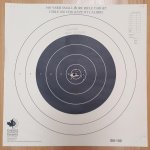
Photo 2: 10-shot Group = 1.123", score = 100-5X. Best group of the day.
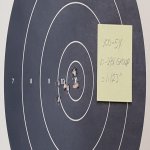
Photo 3: 10-shot Group = 1.638", score = 99-5X
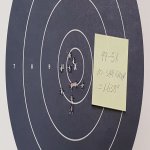
Photo 4: Five 10-shot groups. Elevation and windage dials were used to space the groups on a single target. The wind just started up making the flags move slightly. By groups 4 and 5 the flags were moving and there is a distinct widening of the groups left-right.
Group 1 = 1.889"
Group 2 = 1.601"
Group 3 = 1.704". Two fliers ruined it!
Group 4 = 1.706"
Group 5 = 2.449" (By this time, the wind was now started for the day, and I think it pushed open the group).
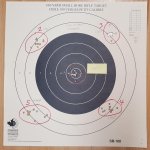
Overall not too bad from the bench. SK Biathlon ammo works relatively well in my rifle, and this lot seems to be reasonably good so far. But I think with some practice I can shoot better for score and group size.
I never settled on final comfortable front and rear iris aperture sizes, and was fiddling with the adjustments throughout the session. This may have accounted for variance in the groups, but impossible to know. The 100m sight picture I found today to be quite different from the 50m, even though this 100-yard target is roughly proportional to the ISSF target at 50m. Maybe it was the bright sun and mirage off the snow. This 100m range shoots downhill, whereas our 50m range is flat.
Front sight aperture sizes (iris) used today ranged from 2.8 to 3.5mm. Rear sight aperture sizes (iris) used today ranged from 1.2 to 1.8mm.
I had a no/low wind morning opportunity to shoot this morning, so I shot some of my 100yard targets at our 100m range from our heated shooting house (again, I am fortunate in these winter months here to have both a 50m and 100m heated shooting houses at my local range).
This is my first "official" test on paper at 100m for my aperture sights. The set-up was my usual bench rest set-up with front Caldwell BR rest and rear Protektor rabbit ear bag. The target I used is the Cible's "100-Yard Small Bore Rifle Target". The aiming bull is 8 inches. The score lines are 1 inch from each other.
X-ring = 1 inch (approx. 1 MOA at 100 yards/m)
10 ring = 2 inches (approx. 2 MOA at 100 yards/m)
9 ring = 4 inches
8 ring = 6 inches, etc.
Target samples and some score and group results are shown below. I think this target's score rings may be overly generous for a benchrest discipline target. I think this target is designed for offhand positional shooting. The 8-inch aiming bull is more than enough at 100m from the bench. For future tests I may make a 6-inch aiming bull and tighter score lines to see how it works and to increase the level of difficulty for bench rest.
Today's ammo: SK Biathlon Sport
Temperature: around 0C and rising (a warm day with melting snow)
Wind: almost nil, but breezes started at the end of the session.
Sun: Very bright, potentially creating some mirage above the snow which can affect score and group.
All groups measured by widest axis to edge of carbon ring, then subtracting 0.22".
Photo 1: A view of the target with sighters and barrel warm-up. About 18 rounds shot, all within the 10 ring. A promising start. No group measured as I was fiddling with turrets, and front and rear iris settings.

Photo 2: 10-shot Group = 1.123", score = 100-5X. Best group of the day.

Photo 3: 10-shot Group = 1.638", score = 99-5X

Photo 4: Five 10-shot groups. Elevation and windage dials were used to space the groups on a single target. The wind just started up making the flags move slightly. By groups 4 and 5 the flags were moving and there is a distinct widening of the groups left-right.
Group 1 = 1.889"
Group 2 = 1.601"
Group 3 = 1.704". Two fliers ruined it!
Group 4 = 1.706"
Group 5 = 2.449" (By this time, the wind was now started for the day, and I think it pushed open the group).

Overall not too bad from the bench. SK Biathlon ammo works relatively well in my rifle, and this lot seems to be reasonably good so far. But I think with some practice I can shoot better for score and group size.
I never settled on final comfortable front and rear iris aperture sizes, and was fiddling with the adjustments throughout the session. This may have accounted for variance in the groups, but impossible to know. The 100m sight picture I found today to be quite different from the 50m, even though this 100-yard target is roughly proportional to the ISSF target at 50m. Maybe it was the bright sun and mirage off the snow. This 100m range shoots downhill, whereas our 50m range is flat.
Front sight aperture sizes (iris) used today ranged from 2.8 to 3.5mm. Rear sight aperture sizes (iris) used today ranged from 1.2 to 1.8mm.
Attachments
Front sight spirit bubble level goodness!
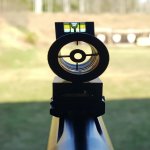
Very glad I added this to the system. This front sight bubble (spirit) level is so good I cannot imagine shooting aperture sights without it. The slightest cant off level seems to make a difference on target for those very small 10 and X rings on the 50m ISSF targets. If I ever get into the decimal scoring system, I am guessing any unwanted cant will significantly affect the decimal scores at 50m.
So now there are 3 front sight parts with 3 separate leveling systems. Complexity adds new issues.
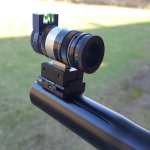
This globe, the Anschutz "M18 Front Sight Rotationally Adjustable" came with the 6834 front and rear sight set I purchased. I thought the rotational globe would be an advantage, and with the plastic inserts I started with, those two sticks you see inside could be adjusted to approximate level, including compensating for a canted rifle position should I want to do that. I see in the competitive shooting videos the experts often set their sights for a canted rifle position. The plastic inserts have no leveling bars, so in the beginning there was only those 2 sticks in the view for level.
Later I added the front sight adjustable aperture (front "iris"), which is also fantastic, and I cannot imagine shooting without it now. Its really nice to be able to simply just turn a dial to adjust the front aperture size for the eye's preference in changing light and target sizes.
But that front aperture/iris threads in and stops where it stops, which sets were the big leveling bar is. It has to be screwed in tight so that the aperture (iris) adjustment dial works independently. The globe can be rotated to level the bars. But that changes the orientation of the globe's sticks. I can sort of line them all up, but not quite. If I make the bar level, the sticks are off level. If I make the sticks level, the bar is off level. But its not a really a problem.
Long story short, my eye and brain always go to the bubble level as the dominant leveling indicator and my brain ignores the other two indicators.
Recent target shot from the bench using benchrest front and rear bags: 50m ISSF target, 4 outer bulls for record out of 200, and a taped on sighter in the middle. Score was 192-7X. The wind got the better of me on target 3 lower left, and one flier.
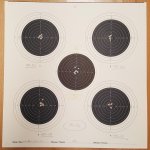
With the nice weather here now, I need to get out of the shooting house, off the bench, and try some offhand positional shooting. I know the groups will open way, way up and score will plummet into the abyss. I have never shot unsupported offhand target, so its going to be "interesting". I may start at 25m just to keep the inevitable disappointment to a minimum.

Very glad I added this to the system. This front sight bubble (spirit) level is so good I cannot imagine shooting aperture sights without it. The slightest cant off level seems to make a difference on target for those very small 10 and X rings on the 50m ISSF targets. If I ever get into the decimal scoring system, I am guessing any unwanted cant will significantly affect the decimal scores at 50m.
So now there are 3 front sight parts with 3 separate leveling systems. Complexity adds new issues.

This globe, the Anschutz "M18 Front Sight Rotationally Adjustable" came with the 6834 front and rear sight set I purchased. I thought the rotational globe would be an advantage, and with the plastic inserts I started with, those two sticks you see inside could be adjusted to approximate level, including compensating for a canted rifle position should I want to do that. I see in the competitive shooting videos the experts often set their sights for a canted rifle position. The plastic inserts have no leveling bars, so in the beginning there was only those 2 sticks in the view for level.
Later I added the front sight adjustable aperture (front "iris"), which is also fantastic, and I cannot imagine shooting without it now. Its really nice to be able to simply just turn a dial to adjust the front aperture size for the eye's preference in changing light and target sizes.
But that front aperture/iris threads in and stops where it stops, which sets were the big leveling bar is. It has to be screwed in tight so that the aperture (iris) adjustment dial works independently. The globe can be rotated to level the bars. But that changes the orientation of the globe's sticks. I can sort of line them all up, but not quite. If I make the bar level, the sticks are off level. If I make the sticks level, the bar is off level. But its not a really a problem.
Long story short, my eye and brain always go to the bubble level as the dominant leveling indicator and my brain ignores the other two indicators.
Recent target shot from the bench using benchrest front and rear bags: 50m ISSF target, 4 outer bulls for record out of 200, and a taped on sighter in the middle. Score was 192-7X. The wind got the better of me on target 3 lower left, and one flier.

With the nice weather here now, I need to get out of the shooting house, off the bench, and try some offhand positional shooting. I know the groups will open way, way up and score will plummet into the abyss. I have never shot unsupported offhand target, so its going to be "interesting". I may start at 25m just to keep the inevitable disappointment to a minimum.
Attachments
Last Step in "Getting Started": First Attempt at 3-Position Unsupported Shooting!
PART 1:
Well, I got my lazy carcass off the bench, off the front mechanical rest and rear bag, out of the comfy dry shooting house (with BR only), and headed out into one of our wet muddy outdoor ranges here at my local range, for my 1st attempt at unsupported 3-position shooting at 50m.
The target I used is the 50m SFC Sporting Rifle target, in practice matches made up of four 5-round target bulls, max potential score 50-5x each, for a total max potential score of 200-20X each. The SFC sporting rifle rings are more generous than the ISSF target, and I need all the help I can get. Rifle is Anshutz 1907. I knew it was going to be heavy with its 26-inch target barrel, but man was it heavy!
I may have missed the fitness window by a decade or two for unsupported shooting. I cannot really hold steady that heavy rifle at all. My over 60 body has begun its downward disintegration trajectory, (back issues), and pain management is a reality. Not going to whine about it, but let's just say it was not the most enjoyable shooting I have done. But grit teeth and carry on.
I shot 4 practice matches in 4 shooting positions: (1) prone with a sling (I understand that SFC Sporting Rifle prone does not allow a sling, but ISSF does); (2) kneeling no sling; (3) standing no sling; and lastly (4) standing while resting the rifle stock forearm on a sandbag on top of a tall tripod.
This 4th shooting method with the stock forearm supported on a post is, I understand, a discipline in aperture shooting for seniors in some jurisdictions. So, I added it to try it out, and in fact it was very comfortable.
Overall results: Not good for the unsupported positions. I was very shaky holding this heavy rifle and could not get the balance with the factory stock. Groups were wildly open as expected, and scores were pathetic. Nowhere near competitive. But gotta start someplace and work up.
Gear set-up and Results:
Wind conditions were strong winds with gusts. I did not bother with flags because I was in a narrow 2-lane range, and was expecting to be very shaky anyway where the hits would be widely dispersed.
Prone: Photo 1 shows the gear. Rifle and aperture sights are the same as described in the original posts on this thread. Installed under the stock's forearm rail here is one of those micro bipods (virtually "weightless") for resting the rifle upright. It is lifted off the ground when shooting.
That mat is not padded except for a narrow thin pad in the elbow area. (I have a padded shooting mat on back order). My old carcass is going to need a thicker padded mat! Small bag for an extra elbow pad. (I do not have a shooting jacket). Shooting glove for the left hand (protects wrist and hand from the sling abrasion).
USGI style sling. This USGI sling proved very effective. The arm loop can be snugged very tight above the left arm bicep, and it did not slip. I have a regular target shooting sling, but it slips off my arm, and it needs a shoulder hook from a shooting jacket which I do not have.
To the right is a black mesh tarp for catching the ejected brass.
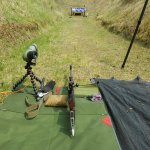
Photos 2 and 3 shows the sling and quick detach Anschutz sling swivel ball joint type I added to it, that snaps easily into and out of the hand stop that comes with the 1907. Detaching and re-attaching that sling fast and often was necessary to be able to get up without the rifle attached to do other stuff, and to stretch often for pain relief. I may be doing something wrong because the left support arm got painful with the support weight and sling tension. (Also on the sling are Uncle Mike type swivels for my other sporter rifle sling studs).
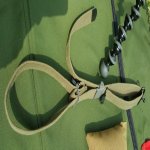
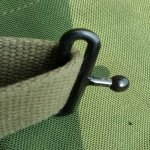
Ammo today was SK Flat Nose Match ("purple"). Shoots OK in my benchrest tests, not my rifle's best ammo but not bad.
Photo 4 is the prone target. Score = 189-3X
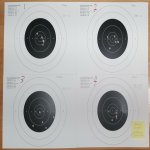
Kneeling, no sling: Photo 5 shows the change of the spotting scope tripod to higher (I don't have a proper spotter stand post yet), and the kneeling roll. For me the kneeling roll is essential for ankle support under the rear foot, otherwise its not possible for me to kneel with weight on the rear.
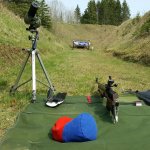
Photo 6 is the kneeling score = 171-1X
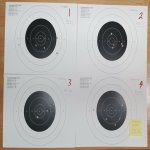
Continued in Part 2, see next post....
PART 1:
Well, I got my lazy carcass off the bench, off the front mechanical rest and rear bag, out of the comfy dry shooting house (with BR only), and headed out into one of our wet muddy outdoor ranges here at my local range, for my 1st attempt at unsupported 3-position shooting at 50m.
The target I used is the 50m SFC Sporting Rifle target, in practice matches made up of four 5-round target bulls, max potential score 50-5x each, for a total max potential score of 200-20X each. The SFC sporting rifle rings are more generous than the ISSF target, and I need all the help I can get. Rifle is Anshutz 1907. I knew it was going to be heavy with its 26-inch target barrel, but man was it heavy!
I may have missed the fitness window by a decade or two for unsupported shooting. I cannot really hold steady that heavy rifle at all. My over 60 body has begun its downward disintegration trajectory, (back issues), and pain management is a reality. Not going to whine about it, but let's just say it was not the most enjoyable shooting I have done. But grit teeth and carry on.
I shot 4 practice matches in 4 shooting positions: (1) prone with a sling (I understand that SFC Sporting Rifle prone does not allow a sling, but ISSF does); (2) kneeling no sling; (3) standing no sling; and lastly (4) standing while resting the rifle stock forearm on a sandbag on top of a tall tripod.
This 4th shooting method with the stock forearm supported on a post is, I understand, a discipline in aperture shooting for seniors in some jurisdictions. So, I added it to try it out, and in fact it was very comfortable.
Overall results: Not good for the unsupported positions. I was very shaky holding this heavy rifle and could not get the balance with the factory stock. Groups were wildly open as expected, and scores were pathetic. Nowhere near competitive. But gotta start someplace and work up.
Gear set-up and Results:
Wind conditions were strong winds with gusts. I did not bother with flags because I was in a narrow 2-lane range, and was expecting to be very shaky anyway where the hits would be widely dispersed.
Prone: Photo 1 shows the gear. Rifle and aperture sights are the same as described in the original posts on this thread. Installed under the stock's forearm rail here is one of those micro bipods (virtually "weightless") for resting the rifle upright. It is lifted off the ground when shooting.
That mat is not padded except for a narrow thin pad in the elbow area. (I have a padded shooting mat on back order). My old carcass is going to need a thicker padded mat! Small bag for an extra elbow pad. (I do not have a shooting jacket). Shooting glove for the left hand (protects wrist and hand from the sling abrasion).
USGI style sling. This USGI sling proved very effective. The arm loop can be snugged very tight above the left arm bicep, and it did not slip. I have a regular target shooting sling, but it slips off my arm, and it needs a shoulder hook from a shooting jacket which I do not have.
To the right is a black mesh tarp for catching the ejected brass.

Photos 2 and 3 shows the sling and quick detach Anschutz sling swivel ball joint type I added to it, that snaps easily into and out of the hand stop that comes with the 1907. Detaching and re-attaching that sling fast and often was necessary to be able to get up without the rifle attached to do other stuff, and to stretch often for pain relief. I may be doing something wrong because the left support arm got painful with the support weight and sling tension. (Also on the sling are Uncle Mike type swivels for my other sporter rifle sling studs).


Ammo today was SK Flat Nose Match ("purple"). Shoots OK in my benchrest tests, not my rifle's best ammo but not bad.
Photo 4 is the prone target. Score = 189-3X

Kneeling, no sling: Photo 5 shows the change of the spotting scope tripod to higher (I don't have a proper spotter stand post yet), and the kneeling roll. For me the kneeling roll is essential for ankle support under the rear foot, otherwise its not possible for me to kneel with weight on the rear.

Photo 6 is the kneeling score = 171-1X

Continued in Part 2, see next post....
Attachments
PART 2:
Standing, no sling: Photo 7 shows the higher spotter tripod on the left, and the tripod on the right with a bag on it for resting the rifle on (bolt open) between shots, relieving weight.
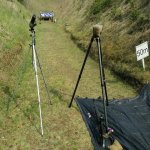
Photo 8 is the standing score, 154-0X. This was really really bad. Bull #1 has only 4 rounds on it. One round missed the paper completely. Standing unsupported I was incredibly shaky, and I don't know with training if it will get any better.
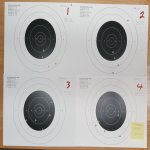
Standing, supported: Photo 9 shows the tall tripod with the bag on it used to rest the rifle on while shooting. This was very comfortable and enjoyable to shoot, steady, and no significant back pain.
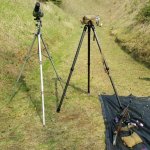
Photo 10 is the standing supported score = 199-10X.
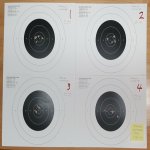
Picture 11 is a graph of the scores from worst to best with the shooting positions. No mystery here. Prone is the most stable unsupported position.
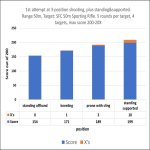
Supported on the tripod bag is a completely different discipline so its score is not comparable to unsupported - its just there for reference to compare against my benchrest groups shown in previous posts. My BR groups are significantly smaller than standing supported on the tripod bag, so I have some work to do to get better at standing supported. I need to shoot supported with the ISSF target to see how different the score is from the BR scores.
This experience only increases my admiration and respect for the amazing skills of the target shooters who can consistently score 9's and 10's and X's shooting 3-Position disciplines, both Sporting Rifle and ISSF.
Overall Conclusion:
I think that this Anschutz 1907 target rifle's balance in the factory configuration is way too far out beyond my left support hand. I stand only 5'4". The length of pull is set to minimum 13", (I need a LoP about 12"), and its overall balance with that 26-inch heavy barrel way out there, means it just does not feel right. In fact, it feels terrible.
Standing, my left support hand must be back under the trigger guard to have my elbow contact my side torso for support, which feels like too much weight out beyond the support arm. This is way inside the balance point which is out where I have the hand stop set. The support arm does not feel solid. With the right arm I have to pull hard on the pistol grip inwards and downwards because the rifle is tilting down and away from the left support hand. An underarm hook addition to the factory butt plate assembly might help if I can fit one to it.
I need to add a grip riser block system under the trigger guard area (maybe 2 to 4 inches thick), for improving the reach for my left support arm. Maybe that will allow a better anchor for the elbow into the side torso, and on the leg when kneeling.
I will have to work on these ergonomic stock alterations and see what happens.
Standing, no sling: Photo 7 shows the higher spotter tripod on the left, and the tripod on the right with a bag on it for resting the rifle on (bolt open) between shots, relieving weight.

Photo 8 is the standing score, 154-0X. This was really really bad. Bull #1 has only 4 rounds on it. One round missed the paper completely. Standing unsupported I was incredibly shaky, and I don't know with training if it will get any better.

Standing, supported: Photo 9 shows the tall tripod with the bag on it used to rest the rifle on while shooting. This was very comfortable and enjoyable to shoot, steady, and no significant back pain.

Photo 10 is the standing supported score = 199-10X.

Picture 11 is a graph of the scores from worst to best with the shooting positions. No mystery here. Prone is the most stable unsupported position.

Supported on the tripod bag is a completely different discipline so its score is not comparable to unsupported - its just there for reference to compare against my benchrest groups shown in previous posts. My BR groups are significantly smaller than standing supported on the tripod bag, so I have some work to do to get better at standing supported. I need to shoot supported with the ISSF target to see how different the score is from the BR scores.
This experience only increases my admiration and respect for the amazing skills of the target shooters who can consistently score 9's and 10's and X's shooting 3-Position disciplines, both Sporting Rifle and ISSF.
Overall Conclusion:
I think that this Anschutz 1907 target rifle's balance in the factory configuration is way too far out beyond my left support hand. I stand only 5'4". The length of pull is set to minimum 13", (I need a LoP about 12"), and its overall balance with that 26-inch heavy barrel way out there, means it just does not feel right. In fact, it feels terrible.
Standing, my left support hand must be back under the trigger guard to have my elbow contact my side torso for support, which feels like too much weight out beyond the support arm. This is way inside the balance point which is out where I have the hand stop set. The support arm does not feel solid. With the right arm I have to pull hard on the pistol grip inwards and downwards because the rifle is tilting down and away from the left support hand. An underarm hook addition to the factory butt plate assembly might help if I can fit one to it.
I need to add a grip riser block system under the trigger guard area (maybe 2 to 4 inches thick), for improving the reach for my left support arm. Maybe that will allow a better anchor for the elbow into the side torso, and on the leg when kneeling.
I will have to work on these ergonomic stock alterations and see what happens.
Attachments
Thanks CC! The 1907 weighs about 12 pounds with the sights.
I did some tests at home with wood blocks taped under the rifle between the trigger guard and hand stop to calculate the grip riser height I need for standing and kneeling. I figure I need about 2" to 3" of riser grip blocks to best support the rifle for kneeling and standing.
Online I found several commercially manufactured grip blocks (palm rests). These can attach to the stock forearm UIT rail and are adjustable for many heights and angles.
Beautifully made, super functional, but rather expensive for my budget at the moment, so I am going to try and make something from my spare parts bin.
The trigger guard on the 1907 is broad and flat, with a few untapped holes in it that look like it was intended to attach grip blocks to with machine screws and nuts. I am working on an adjustable grip block design that should greatly improve the ergonomics. Prototype is in the works.
I did some tests at home with wood blocks taped under the rifle between the trigger guard and hand stop to calculate the grip riser height I need for standing and kneeling. I figure I need about 2" to 3" of riser grip blocks to best support the rifle for kneeling and standing.
Online I found several commercially manufactured grip blocks (palm rests). These can attach to the stock forearm UIT rail and are adjustable for many heights and angles.
Beautifully made, super functional, but rather expensive for my budget at the moment, so I am going to try and make something from my spare parts bin.
The trigger guard on the 1907 is broad and flat, with a few untapped holes in it that look like it was intended to attach grip blocks to with machine screws and nuts. I am working on an adjustable grip block design that should greatly improve the ergonomics. Prototype is in the works.




























































































